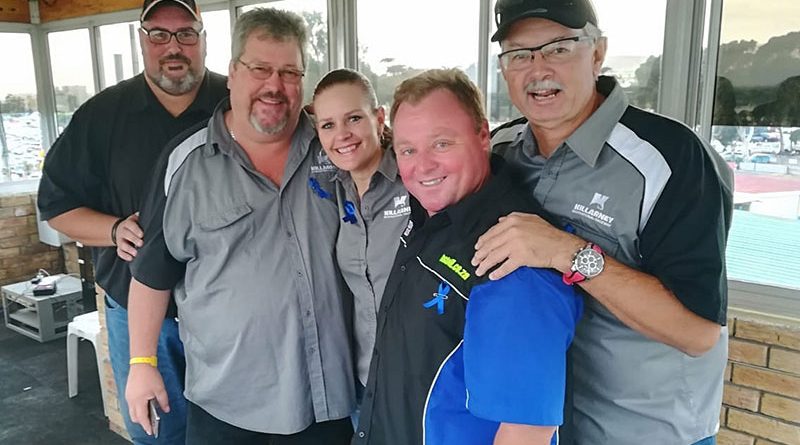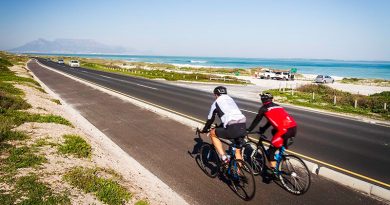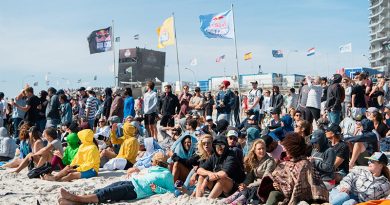Behind the Scenes at Killarney
In the first of a new series about the people who make racing at Killarney possible, we take you all the way to the top.
To the fifth floor of the control tower, where the commentators stand all day on race days, in a glass box (it has to have windows all round!) giving Killarney its voice and keeping you up to speed with what’s happening on the parts of the circuit you can’t see, as each race unfolds.
It’s a big ask: Not only do you need to watch the action all round the circuit, you have to keep an eye on the live timing monitor, while turning what you see into words – in real time! – speaking clearly and concisely all the time.
Turn the sound off and try it sometime while you’re watching motorsport online.
More than that, you need to be able to recognise the individual competitors’ cars or motorcycles at a glance from up to 600 metres away (bearing in mind that the bigger categories field up to 50 cars at a time) and you need to know a little about the leading drivers and their machines in each class – details that are not in the programme.
One member of the commentary crew sits all day with a radio glued to his ear, listening to race control and passing information on to the commentators.
So it follows that the commentators are all deeply invested in motorsport, even though all of them have day jobs as well, and they spend a lot of off-duty time talking to the competitors about how they do what they do. They also do live crossings on air to the various radio stations that help us to promote motorsport at Killarney.
You can’t just pitch up on race day and do this job – you have to do your homework.
Killarney’s public address system suffers from the same problems as at all outdoor events; the sound from speakers further away reaches fans after that from speakers nearby, causing what sounds like an echo. There’s also a high level of ambient noise, often making the commentary difficult to follow.
The Killarney commentators have addressed these problems with a high-tech solution: their commentary is not only broadcast on the public address system but also on FM radio – tune your portable or car radio to 108 FM for crystal clear commentary.
We thank the Western Cape Motorsport Commentators; racing at Killarney – including Main Circuit, Short Circuit, Rallycross, Karting and Oval Track events – would be a lot less exciting for the spectators without them.
MARSHALS
No motorsport is possible without marshals. Their flag signals warn competitors of changing track conditions, problems around the next corner, slow moving vehicles ahead of you and faster moving vehicles coming up behind you.
Each post is also in constant contact with race control, to warn the clerk of the course of incidents or hazards on the circuit.
Most important of all, they are on the spot to help you when you crash (and we all do from time to time!) to take care of you in the vital few seconds before the medics get there, and to put out the fires that can – and do – erupt when petrol gets spilled on to hot metal.
But there’s a lot more to being a marshal than that: The marshals also control the entrance and exit to pit lane, crew the fire response vehicle and provide the members of the extraction team. That’s exactly what its name says it is – a team of highly trained marshals whose job it to extract the driver from a burning or dangerously unstable vehicle.
Until 2018 Killarney’s extraction team was officially the fastest in the world; in 2019 they lost the title to a team (mostly made up of professional rescue personnel) from a European circuit – by mere tenths of a second!
The Killarney marshals began as a offshoot of the Metropolitan Motorcycle and Car Club in the late 1950s and when the ‘Mets’ merged with three more clubs to form an umbrella body for the circuit in 1965, they became a founding section of the new Western Province Motor Club.
It takes at least 40 marshals (the more the better!) to run a main-circuit race day or practice day, about half that number to ensure safety at a Short Circuit, Rallycross or Drag Racing meeting. Given that Killarney hosts about 200 events per year, nearly all of them needing marshalling, you will understand why the Marshals Section say they can never have enough man (and woman) power.
Especially as the marshals are all volunteers; they are paid a stipend to cover their transport costs, their uniforms are sponsored and they get lunch on main-circuit race days.
That said, in these uncertain times many of our marshals, especially those drawn from previously disadvantaged areas in the vicinity, are otherwise unemployed, and that stipend is their only income. They have become stalwart members of the Killarney family, and their dedication to being the best marshals they can be, is exemplary.
RACE CONTROL
During main-circuit events the race control office at the base of Killarney’s control tower looks like a cross between an outside broadcast unit and launch control at the Kennedy Space Centre, with banks of TV monitors, computers and radio microphones.
The comparison is in fact an appropriate one, because this is the nerve centre of main-circuit racing at Killarney International Raceway. This is where the decisions are made and where the ultimate responsibility for the safety of the competitors lies.
That responsibility rests with the Clerk of the Course, who is also in charge of deploying and recalling the Safety Car and, in the case of a serious incident on the track, is also the only person allowed to stop a race by ordering the marshals to display a red flag at each marshal’s post.
This is usually, but not always, at the request of the marshals themselves, who are first on the scene when things go wrong on the circuit.
The Clerk of the Course is also responsible for ensuring that each race is run according to the rules set out in the Supplementary Regulations (the format sent out to competitors ahead of the meeting, inviting them to enter), as well as the rules governing motorsport, as laid down by Motorsport South Africa and, ultimately, the International Automobile Federation in Geneva, Switzerland.
For this reason, the Clerk of the Course is not necessarily a single person. Each class of racing may have their own CoC, who is expert in the rules governing that class, and who takes charge of race control when ‘his’ races are being run.
The Clerk of the Course is also the first line of inquiry should there be a protest or disciplinary action against a competitor.
Backing him up in race control are two very important functionaries. The radio officer is in constant communication with the marshals around the circuit, relaying their reports to the Clerk of the Course and the COC’s instructions to the marshals.
The camera controller is responsible for monitoring the images captured by the closed-circuit cameras that cover the entire circuit and displayed on the monitors in race control.
He’s able to pan individual cameras remotely and zoom in for a detailed view of any part of the circuit, giving the Clerk of the Course visual information of what is happening in real time. The footage from all the cameras is recorded so as to settle any later disputes – and to show alleged transgressors exactly why they are being disciplined.
This sometimes brings the Clerk of the Course into conflict with competitors, but it must always be borne in mind that the most important function of race control is the safety of the competitors, and this is where the buck stops if anybody gets hurt.
SCRUTINEERING
The overriding responsibility of the scrutineers is the safety of the competitors. It is their job to ensure that each competitor’s car or motorcycle conforms to all the safety requirements laid down in the regulations for that class, and for racing in general by Motorsport South Africa.
Some of the possible problems the scrutineers look for are self-evident: There must be no oil, coolant or brake-fluid leaks, each wheel must have all its wheel-nuts in place and tight (don’t laugh), there must be no cracks in the windscreen, the driver’s seat must be firmly and correctly fastened to the floor of the vehicle and the safety harness or seat belt must be correctly mounted to the body of the car.
All of these apply even to the street-cars participating in #RobotRacing and Street2Strip events.
When it comes to racing cars and motorcycles, however, it gets interesting: All sump plugs and drain plugs must be safety-wired, and on motorcycles the front brake calliper mounting bolts must also be lock-wired. All breather tubes must empty into a suitable container.
The battery and fuel tank must be separated by a firewall and each must be correctly fastened to the body of the car. The roll cage must be of the approved type and correctly mounted. There must be clearly marked towing points front and rear, as well as a master electrical cut-off switch inside the car, and another on the outside. Most importantly, in the case of a closed car, both front doors must be able to be opened from the outside so that the marshals can reach the driver after a crash.
All safety harnesses have their date of manufacture on the label, and are guaranteed by the makers for five years. Due to the cost of these harnesses, Motorsport South Africa has extended their permissible lifespan by another five years, provided that they show no visible UV damage, cuts or nicks – but after 10 years they must be replaced.
Lastly, the driver or rider has to present his or her vehicle for scrutiny in person, in order that his helmet and racing suit can also be checked for safety compliance. All of these checks are focused on ensuring maximum protection for the competitor in a crash; the scrutineers will tell you that few drivers (and still fewer riders) will argue if the scrutineers spot a safety issue on their vehicles.
The scrutineers also have another vital function: They are also responsible for ensuring that each vehicle complies with the rules for the category in which it competes. Simply put, this is to ensure that the racing is fair and that no competitor enjoys an unfair advantage.
In practice, however, it’s not that simple. This requires detailed knowledge of the class rules, read together with the general motorsport regulations, and is usually left to specialists who are expert in each category.
Often a competitor will argue that his vehicle is eligible when a scrutineer says it’s not. The scrutineer will then refer to the chief scrutineer for second opinion, and the competitor may refer to the Clerk of the Course if he wishes.
Nevertheless, the scrutineers insist that they are there to facilitate the racing, not to stop competitors from taking part. If they find an issue on the car or motorcycle, they will always try to refer you to a workshop at the circuit, or even a fellow competitor who can help you sort out the problem, and as far as possible they will make themselves available to re-inspect the car or motorcycle, so that it can get the all-important ‘scrutineering sticker’ and be ready to race.
Theirs is a finicky job, where the devil is literally in the details, but our safety is in their hands, and we salute the Killarney scrutineers for being as thorough as they are.
MAINTENANCE
All the maintenance, repairs, housekeeping and building works at Killarney International Raceway are carried out by a crew of less than 20 people, who accomplish an extraordinary variety of tasks, under stringent budget constraints, almost unnoticed by competitors and motorsport fans alike.
Before each event, the circuit’s tyre barriers, demarcations and marshal points are set up for that particular discipline – be it Main Circuit, Drag Racing, Short Circuit, Rallycross or any one of a number of specialised events.
The circuit is cleaned with blowers, the verges are sprayed to stop weeds breaking up the edge of the tar and eventually destroying the track, the grass is mowed all round the circuit as well as in the spectator areas as necessary, and the run-off areas are scarified to make them soft and energy-absorbent – an important safety factor when cars run off the circuit in the heat of battle.
The maintenance team are also responsible for constructing, installing and maintaining the tyre barriers around the circuit, and for casting, painting and installing the concrete ‘Jerseys’ that provide movable safety barriers where needed around the circuit.
During most events the crew are on standby to empty refuse bins and carry out running repairs to the infrastructure, while each event is followed by a complete clean-up and maintenance check. Given that Killarney hosts approximately 200 events a year, it’s not unusual to have a motorsport event on a Saturday followed by a cycling or charity event the next day – and that means the maintenance crew are on the job while the rest of us are still sleeping on Sunday morning.
Every Wednesday afternoon the maintenance staff set up the infrastructure for #RobotRacing, and every Thursday morning the circuit has to be ready for testing or private hire before 9:00am.
Perhaps the least-known aspect of the maintenance crews’ responsibilities is the never-ending fight against water leaks. As we all know, the Killarney complex has been built up over the years; most of the water supply system is now more than 50 years old and subject to unpredictable leaks and breaks.
Each of these has to to be traced, dug up and repaired – which can be a problem when the leak is under a building or, worse still, under the circuit (both of which have happened recently). The maintenance team is also busy with an ongoing project to use harvested rainwater for flushing toilets and watering the grass in the spectator areas and around the Clubhouse.
Painting all the buildings and the safety infrastructure around the circuit is a never-ending project – by the time the team has finished painting all the walls, fences and roofs, it’s time to start again!
In between all of this, they also find time for building projects ranging from small drains to huge grandstands, as well as repairing fences and walls around the complex, especially when members of the public crash their cars through the wall along Potsdam road, which happens more often than you’d think.
In many ways the maintenance staff are the unsung heroes of Killarney – always busy in the background, making things work. Even during the current lockdown due to the coronavirus pandemic a skeleton crew have been busy tracing water leaks, repairing and upgrading various facilities, and patrolling the complex to help prevent vandalism and theft.
ADMIN
In order to present a motorsport event at Killarney, an extraordinary number of arrangements have to be coordinated, from sending out the Supplementary Regulations (the format sent out to competitors ahead of the meeting, inviting them to enter), to correlating the entries, drawing up the entry lists, coordinating the security arrangements, issuing tickets and pit passes, liaising with the sponsors and the media, writing and collating the programme, stocking the bars and restaurants and catering for the guests in the Tower Lounge – and taking care of 101 last-minute queries, late entries and minor organisational crises.
All of which is done by a dozen dedicated motorsport enthusiasts in the admin building – among them the four smiling ladies in our picture.
Now consider that they do this 200 times a year, and you’ll understand that this is not a job for sissies. The admin staff spend huge amounts of time at the circuit, often outside of working hours because motorsport happens at weekends (or on Wednesday nights!) And there are sometimes two events in a weekend, which means they are busy late on Saturday night or at the crack of dawn on Sunday to get ready.
The admin crew are no less busy during the week, answering hundreds of telephonic and email queries, arranging, scheduling and facilitating payment for private and corporate circuit hire, and looking after the extended Killarney family who occupy garages and workshops at the complex.
They also have to ‘think out of the box’ to come up with exciting new promotions and spectator competitions, market the facility as a function venue and work on ways to attract new sponsors, as many of our traditional supporters move away from motorsport to more telegenic events such as football tournaments.
Yet every time you come into the admin block you are met by smiling faces and friendly greetings, because the people there are first and foremost motorsport enthusiasts – they couldn’t do this job if they weren’t.




